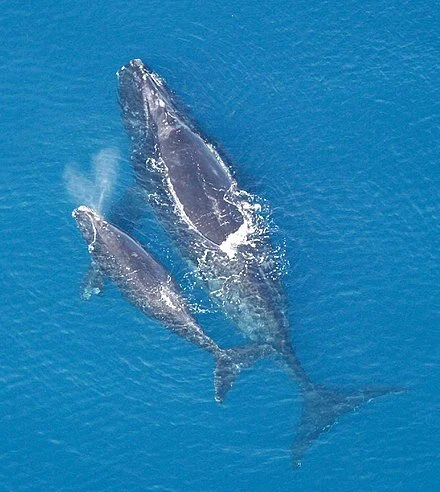Study is aimed at protecting right whales in offshore windpower areas
North Atlantic right whale mother with calf
From ecoRI News (ecori.org)
Ørsted is funding a project to study and protect endangered North Atlantic right whale during surveys, construction and operation of its U.S. offshore wind facilities such as Bay State Wind and Revolution Wind.
Using data collected from an aerial, unmanned glider and two sound-detection buoys, researchers from the University of Rhode Island, Rutgers University and the Woods Hole Oceanographic Institution will examine the habitat and behaviors of right whales in the wind-lease areas awarded to Ørsted.
An estimated 400 North Atlantic right whales remain, fewer than 100 are breeding females.
The oceanographic data will help studies of additional fish species and improve forecasting for severe storms and other weather, according to Ørsted. The three-year initiative is called Ecosystem and Passive Acoustic Monitoring (ECO-PAM).
Vineyard Wind watch
A key offshore wind report is expected this week from the Coast Guard. The draft of the Massachusetts and Rhode Island Port Access Route Study (MARIPARS) will recommend wind farm layouts, spacing, and transit lanes for vessel safety, navigation, and search-and-rescue operations.
The draft report will be followed by a 45-day comment period. The Coast Guard is expected to finalize the report in April.
At its nearest point, the Vineyard Wind project is about 14 miles from the southeast corner of Martha’s Vineyard and a similar distance from the southwest side of Nantucket. (BOEM)
At its nearest point, the Vineyard Wind project is about 14 miles from the southeast corner of Martha’s Vineyard and a similar distance from the southwest side of Nantucket. (BOEM)
The recommended wind-facility grid is expected to inform the forthcoming draft environmental impact statement (EIS) from the Bureau of Ocean Energy Management (BOEM) for the Vineyard Wind project. If adopted by BOEM, MARIPARS will accelerate other wind proposals in the federal lease areas off southern New England.
BOEM won’t give any hints about when it will release the expanded EIS for the Vineyard Wind project. BOEM media representatives will only say to look for updates at its Vineyard Wind Web site.
The expanded EIS will focus on fishing and other impacts of offshore wind development in the region. The initial EIS was expected by the end of last year but pushed until early 2020.
The initial EIS was delayed last summer after the National Marine Fisheries Service and the National Oceanic and Atmospheric Administration declined to endorse the report.
After hearings and a public comment period on the upcoming EIS, a record of decision from BOEM on the Vineyard Wind project isn’t likely until December. If approved, major work on the 800-megawatt wind facility, such as pile driving, can’ commence until May 1, 2021. An agreement to protect North Atlantic right whales with three environmental groups signed last year prohibits such work between January and April.
Foster wind moratorium
The Foster (R.I.) Town Council recently approved a 180-day moratorium on wind-turbine development. There are no proposals before the town, but the council wants to give the Planning Board time to write an ordinance for future wind development.
“There’s speculation whether companies would be interested in coming into our town and we want to make sure we had things in order,” Town Council president Denise DiFranco said at the council’s Jan. 23 meeting.
The council can extend or shorten the moratorium. Residential wind systems less than 100 kilowatts are still permitted.
Virginia wind
Virginia is upping its involvement in offshore wind with a vision to reach World War II levels of maritime industrial activity. Last September, Dominion Energy, the owner of natural-gas pipelines and power plants, including the Manchester Street Power Station, in Providence, announced plans for a 2,600-megawatt wind facility off Virginia Beach. Gov. Ralph Northam has since set a state energy target of 30 percent renewable power by 2030 and 100 percent by 2050.
Dominion is also developing a two-turbine offshore test site called the Coastal Virginia Offshore Wind Project with Ørsted. The project could be operational by late this year.
Like many states in the Mid-Atlantic and Northeast, Virginia wants to expand its ports to build maritime centers for wind turbine construction, maintenance, and shipping. An estimated 14,000 jobs could be created by the new maritime industries in the state.
Tim Faulkner is an ecoRI News journalist.
